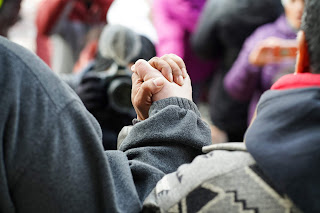I have watched these women for over two years now. My beloved is one of them. They do their work in a corner of a building affectionately called "The Ark" in two rooms they teasingly refer to as the "sweat shop" in part because it is always warm in there and it is in use much of the time.
These women, Linda, Aline, Charla, Judith, Betty, Nancy, Cynthia, Janet, and Doris are coming as close to re-creating shalom as any group of people I know. And, they are doing it quietly and profoundly, often with a few people and God watching, and perhaps their husbands, but those watching are growing exponentially.
We all know the garden story, pristine place, one man, one woman, one tempter, and then comes expulsion and curses to her and to him and resoundingly to all of us. Peace was broken, shalom was shattered. We moved into the space of "this was not the way it was planned." But this was the way it was and this is the way it shall be until the Lord returns and creates the new heaven and new earth.
Until then, we are charged with re-creating shalom. When we march for justice, that is what we are doing. When we encourage young parents to nurture their children, that is what we are doing. When we work to change laws that advantage the racial majority and disenfranchise the minority, that is what we are doing. When we tell stories in the public sphere about injustices done to black farmers that reach all the way back beyond reconstruction to the shores of Africa, that is what we are doing. When we bind the wounds of the broken and connect with the lonely, that is what we are doing.
Re-creating shalom is a big deal. A seriously big deal.
Discrimination and racism are violations of shalom. Poverty is a violation of shalom. Illness in all of its manifestations is a violation of shalom. Children who are cold in the bitter winds of the winter, that is a violation of shalom. Old age and Alzheimer's and dementia and eating alone at the dinner table and dropping food all over are violations of shalom. Children's diseases are a break of shalom. Any type of injustice is a break of shalom. Any break of shalom compels us to figure out how to recreate it, imperfectly though our efforts will be.
And so it is that my beloved and her friends are bringing shalom into the world of these circumstances and many others. They have a righteous cause that is bringing righteousness into the world. Where there are cracks in shalom, they re-institute righteousness. Where people are cold and feeble and frail and diseased, they re-institute righteousness and shalom.
And so, they do more than sew. They are reclaiming shalom and righteousness. Sewing is a beautiful means of bringing about shalom and righteousness.
They sew and sew and sew. Days for Girls (menstrual kits so girls can stay in school), hospital pillows, hospital totes, marble mazes, surgical caps, port pillows, nursing home bibs, baby items, treat bags, scarves and hats for cold kids in Alaska, and blankets for the police to take on their calls for kids who are cold. There is no way of knowing exactly how many pieces their fingers have touched. A rough estimate is around 3,000 in some way or other since 2015.
My beloved is working on a blanket for the police to have available as we speak. A friend and I were joking at our home group last night as to how often he hears the whirring of the sewing machine at his house. "All the time" was his response.
They would deny that it's a big deal. I think they are wrong. I think this is a big deal, a very, very big deal.
As I commented in class yesterday morning as we wrapped up a class on James chapter one where he made the point that true religion is taking care of the widows and the orphans, "We cannot do everything, but we can do something. We cannot do
everything, but we can do
something."
Shalom and justice break through the efforts of these sewing warriors with every cap made for a cold kid in Alaska, when every blanket is given to a child or adult by the police on a house call, when a girl can go to school without shame during her monthly menstrual cycle, an elderly person can eat dinner with a bib on, a kid who struggles to pay attention can fiddle with the maze she has, a chemo patient or any other patient who needs a port pillow to protect the port from the weight of the seat belt, and when a kid going into surgery has a cool, playful cap to wear.
So, here on Martin Luther King, Jr. Day, I salute these justice warriors and their noble efforts.




